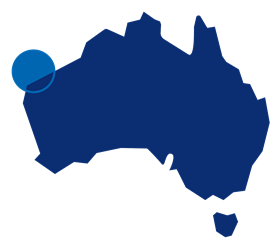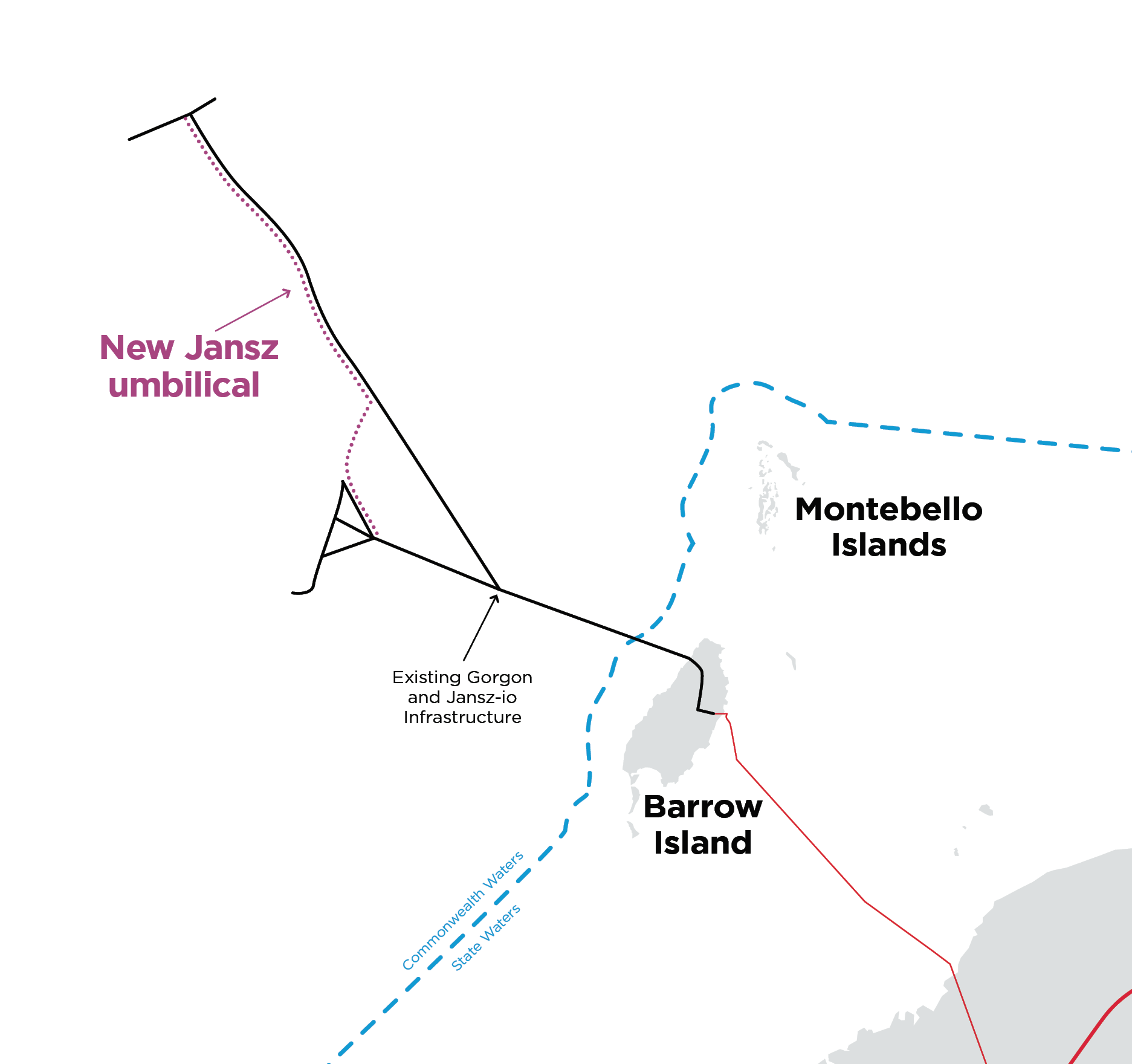relevant persons information
jansz umbilical
Chevron Australia, on behalf of the Gorgon Joint Venture, operates the Gorgon Project (Gorgon) located off the northwest coast of Western Australia (WA).
Since 2015, offshore production wells and pipeline infrastructure have gathered natural gas from the Jansz-Io and Gorgon gas fields and transported it to the Gorgon Gas Facility on Barrow Island. From the Gorgon Gas Facility, gas is processed for export as liquefied natural gas (LNG) or piped to the mainland for WA domestic gas users.
To support the reliability of the Gorgon offshore gas gathering systems, Chevron Australia plans to install an electrical power and communications umbilical (cable) between the Gorgon and Jansz-Io fields, adjacent to existing infrastructure and areas previously disturbed as part of the Gorgon development. The existing Jansz umbilical, which provides chemical, hydraulic, electrical power and communications will remain in use.
The additional umbilical will provide safe and reliable electrical power and communications to Jansz-Io offshore infrastructure, which is critical to maintaining current production levels over the approved life of the Gorgon development and supporting the ongoing delivery of energy to customers in WA and the Asia Pacific region for decades to come.
Chevron Australia is currently developing the Gorgon Gas Development – Jansz Umbilical Environment Plan, which will be submitted for assessment by the National Offshore Petroleum Safety and Environmental Management Authority (NOPSEMA).
This information is intended to assist ‘relevant persons’ to make an informed assessment of the environmental impact and risks of our activities and to provide input and feedback to enhance the EP. Relevant persons are those whose functions, interests or activities may be affected by our activities. This includes Traditional Owners and Custodians’ spiritual and cultural connection to Country, commercial and recreational fishing, tourism, individuals or groups in local communities.
Please note: in the context of an EP, each of the following is considered part of the ‘environment’:
- an ecosystem and their constituent parts, including people and communities
- natural and physical resources
- the qualities and characteristics of locations, places & areas
- the heritage value of places; and
- the social, economic and cultural features of the above.
location and water depth

The Jansz-Io gas field is located within production licences WA-36-L, WA-39-L and WA-40-L, approximately 200 kilometres (km) off the northwest coast of WA in water depths of approximately 1,350 metres (m).
The Gorgon gas field is located within production licences WA-37-L and WA-38-L, ~130 km off the northwest coast of WA in water depths of ~1,350 m, and ~65 km northwest of Barrow Island in water depths of ~200 m.
The umbilical lay route, between the Gorgon and Jansz-Io fields, is adjacent to existing infrastructure and areas previously disturbed as part of the Gorgon development.
Table 1 provides infrastructure details and Figures 1 and 2 show the location and Operational Area (OA).
schedule and duration
Installation of the umbilical is planned to occur between mid-2026 to mid-2028 and is expected to be completed within a 3-month window.
This timing is indicative and subject to vessel availability, delays caused by weather events, and other unforeseen factors.
It is expected works will be undertaken 24 hours a day and 7 days a week for the duration of the activities.
activity overview
Chevron Australia plans to install the following:
- an additional umbilical to supplement power and communications to the Jansz-Io field
- a junction box at the Jansz end of the umbilical and umbilical termination assemblies and flying leads at both the Gorgon and Jansz ends of the umbilical to connect power and communications to existing subsea infrastructure; and
- pipeline crossings and stabilisation mattresses, as required.
Table 1 provides further infrastructure details.
Activities outlined in the EP will include:
- installation of the additional Jansz umbilical infrastructure undertaken by the primary installation vessel / inspection maintenance and repair (IMR) vessel
- non-invasive seabed feature surveys may be conducted before and after installation undertaken by Remotely Operated Vehicles (ROVs)
- pre-commissioning and commissioning undertaken by ROVs and the IMR vessel
- a helicopter may be used for supplies or crew change, where required.
environment that may be affected (EMBA)
As part of our environmental assessment and consultation process, we create an EMBA map to provide geographical context for stakeholders to determine if their functions, interests or activities may be affected by an offshore activity during operations or in an emergency condition.
Figure 1 shows the EMBA, which is based on worst-case environmental scenarios — an unplanned release (oil spill) from a vessel collision and loss of containment from the hydrocarbon system. Shoreline loading refers to areas of the coast that may be impacted by hydrocarbons.
The EMBA has been defined through combining 300 simulations for each unplanned release scenario under different weather and ocean conditions. This means that in the highly unlikely event an unplanned release does occur, a geographical area much smaller than the EMBA would be affected.
The majority of the impacts or risks directly arising from installation activities would occur within close proximity of the OA. Chevron Australia has systematic control measures to prevent and mitigate emergencies and to reduce the impact of planned activities on the environment, including ecological, social and cultural sensitivities.
Table 2 summarises the key impacts or risks and proposed control measures to manage these to levels that are as low as reasonably practicable (ALARP) and acceptable.
safe navigation area and marine exclusion zone
During installation of the infrastructure, notices to mariners will be sought, to advise vessels to navigate with caution.
A temporary 500-metre exclusion zone will be in place around vessels engaged in installation activities.
No new permanent exclusion zones will be sought for the additional umbilical.
first nations cultural values
We acknowledge that Traditional Owners and Custodians in the northwest region of WA have expressed a deep obligation to protect cultural values and features, including songlines, dreaming stories and the fauna connected to them.
Chevron Australia is committed to ongoing engagement and consultation with Traditional Owners and their representative bodies.
This process will continue to inform our understanding of cultural values and features, allow us to risk assess impacts and risks to those features, and help facilitate the co-design of appropriate controls to avoid, minimise and mitigate potential impacts and risks.
marine fauna and biologically important areas
Marine fauna that may be found at the Jansz umbilical location include pelagic and demersal fish species. Some threatened and/ or migratory fish species (e.g. whale sharks, other sharks and manta rays) may transit the area.
As with most offshore areas in WA, a range of marine mammal species are known to transit the Jansz umbilical area including Antarctic minke whales, Bryde’s whales, fin whales, humpback whales, pygmy blue whales, sei whales, sperm whales, killer whales and spotted bottlenose dolphins.
Biologically Important Areas (BIAs) for several marine fauna species overlap the EMBA. Additionally, the pygmy blue whale migration BIA overlaps with the Jansz umbilical OA.
The closest turtle nesting habitats are Barrow, Montebello, and Lowendal islands, ~60 km away from the Gorgon end of the Jansz umbilical. Similarly, shallower internesting BIAs extend a maximum of 60 km from these nesting beaches.
approvals process
Petroleum activities in Commonwealth waters are regulated by NOPSEMA. Before petroleum activities can take place, Chevron Australia must develop an EP which will be assessed by NOPSEMA in accordance with the requirements of the Offshore Petroleum and Greenhouse Gas Storage (Environment) Regulations 2023 (the Regulations).
The Regulations require us to consult with relevant persons whose functions, interests and activities may be affected by the petroleum activity.
Following consultation, we will submit the Gorgon Gas Development – Jansz Umbilical Environment Plan to NOPSEMA, which will:
- describe the environment in which installation activities are planned to take place;
- include an assessment of environmental impacts and risks arising from the activities;
- identify control measures to manage the potential impacts and risks to levels that are ALARP and acceptable; and
- outline how Chevron Australia has engaged with relevant persons and how their feedback has been considered and addressed.
NOPSEMA will assess whether the EP satisfies the Regulations, including whether the environmental impacts and risks of operations will be managed so that they are ALARP and acceptable before accepting the EP.
impacts, risks and proposed controls
A summary of impacts/risks and key proposed controls for Jansz umbilical installation activities can be viewed in Table 2.
your input
We are now seeking your feedback and input if you consider your functions, interests, or activities may be affected based on the information provided, including the summary of the key environmental impacts and risks identified to date in Table 2.
We encourage you to provide additional details about the environment, aspects, consequences of the activity or control measures or to ask for further information or consultation by 16 May 2025.
You can contact us with any questions, requests for information, or to provide feedback by calling tollfree on 1800 225 195 or online below.
Relevant persons may request that the information they provide be treated as confidential. Chevron Australia will make this known to NOPSEMA and it will be identified as sensitive information and not published in the EP.
what's next
The feedback we receive during consultation will be used to inform and enhance the EP before it is submitted to NOPSEMA for assessment.
We commit to keeping you informed and providing responses to any relevant person who so requests.
privacy notice
If you choose to provide feedback on this proposal, Chevron Australia will collect your name and contact details, in addition to your comments, for the purposes of maintaining contact with you and inclusion of your feedback in our submission to NOPSEMA. Provision of this information is purely voluntary, however if you choose not to provide it, we may not be able to contact you in the future regarding your submission. Chevron may transfer your information to NOPSEMA, if required and if you do not identify it as sensitive, and to other Chevron affiliates including our head office based in the United States. For further information regarding how we protect your personal information, and your rights, please refer to our privacy notice.
further information
resources
- Consultation on Offshore Petroleum Environment Plans – NOPSEMA pdf opens in new window
- Environment plan content requirements – NOPSEMA pdf opens in new window
- Environmental requirements – NOPSEMA opens in new window
- NOPSEMA Assessment Process Environment Plans opens in new window
- Offshore Petroleum Greenhouse Gas Storage (Environment) Regulations opens in new window
- Chevron Operational Excellence Management System (OEMS) opens in new window
- Consultation in the course of preparing an environment plan – NOPSEMA pdf opens in new window
- Jansz Umbilical – relevant persons information sheet pdf opens in new window


